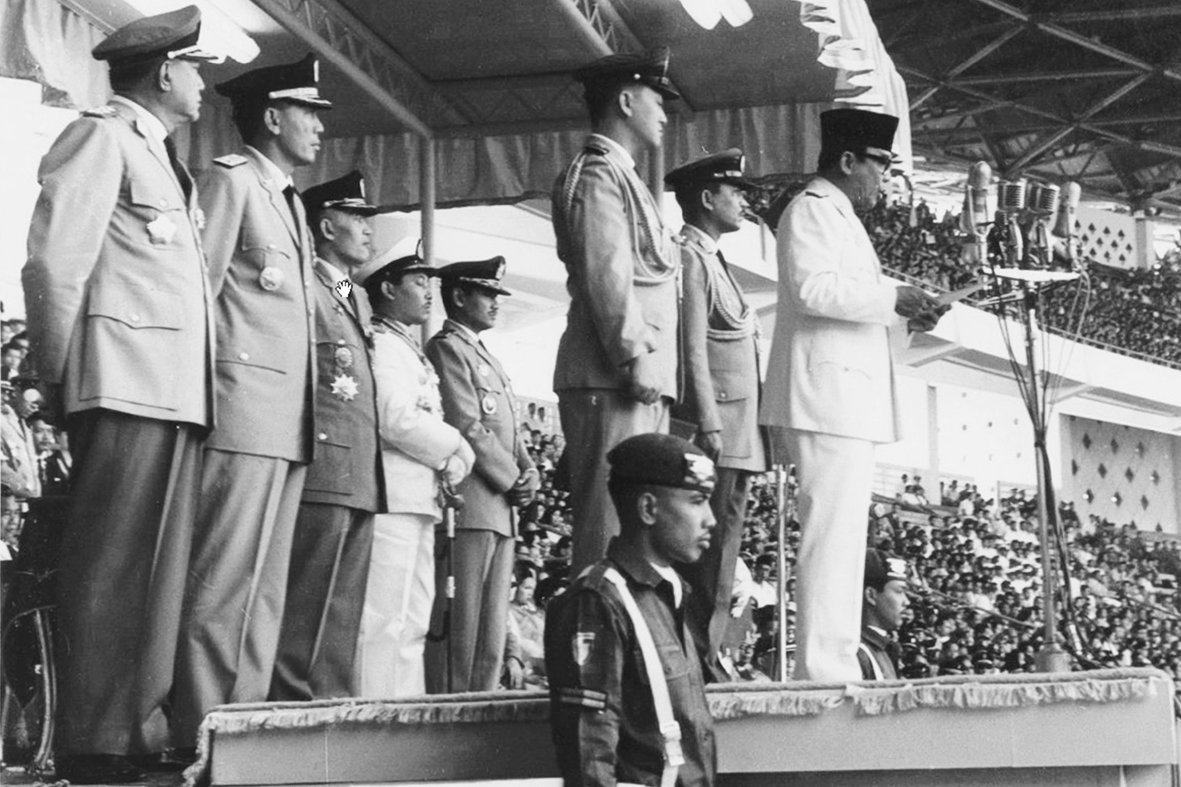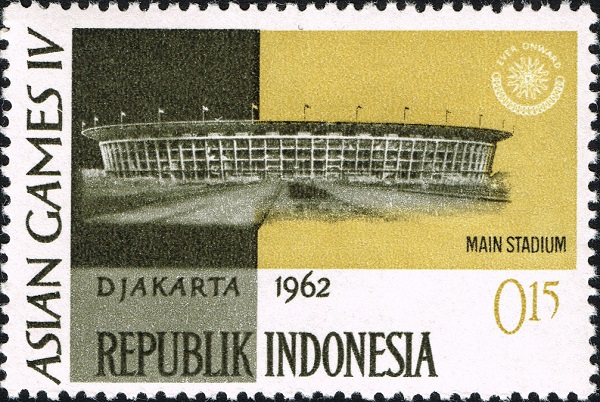Stefan Huebner
The Fourth Asian Games, that took place in Jakarta from 24 August to 4 September 1962, was the first large international sporting event held in Indonesia. The event had great importance in communicating the image of a seemingly successful rapid modernisation and developmental process that was transforming post-colonial Indonesia. The aim of the games was to demonstrate national unity, showcase Jakarta’s urban development and communicate traditional ideas of power. The games furthered the Sukarno administration’s ambition to challenge the power asymmetry vis-à-vis the west and to give Indonesia a significantly more important role on the world stage. This had already been done at the Bandung Conference of 1955 and was continued with the founding of the Games of the New Emerging Forces (GANEFO) in Jakarta in 1963.
The organisers
During the early 1960s, western sports and international sporting events were still comparatively new. During Dutch colonial rule, the spread of sport was very limited. The Far Eastern Athletic Association, a regional sports federation, was founded in 1913 but the Dutch East Indies had only joined in 1934. And participation in the Olympic Games did not come until independence. However, by then the government started to encourage mass sport and also held national sports weeks (Pekan Olahraga Nasional or PON). The Fourth Asian Games served to further promote western sports among Indonesians.
A very important figure in this development was Raden Maladi, Indonesia’s first minister of sport (1962-1966). Maladi had been minister of information from 1959 to 1962 and, before that, head of radio broadcasting service Radio Republik Indonesia. The fact that the most senior organiser was a serving minister of sport, an office created for the Asian Games, illustrates the importance of the games for the Sukarno administration, which intended to have full control over the event. Other leading positions were held by Sultan Hamengku Buwono IX and Prince Paku Alam VIII who were interested in western and Indonesian sports. President Sukarno, Indonesia’s head of state, served as patron of the games.
Destroying the image of backwardness
In 1958, Indonesia was awarded the right to host the Fourth Asian Games. A short while after the decision, Sukarno declared that the games must be ‘better’ than previous Asian Games. Basically, he intended to hold a more impressive event than Japan, the most developed Asian nation, had done at the Third Asian Games in 1958. These games were held in Tokyo and had impressed many of the world’s leading sports officials so greatly that the city was soon afterwards awarded the 1964 Olympic Games. Maladi and others had similarly high ambitions.
Sukarno and his colleagues’ main goal was to shed the image of Indonesian backwardness – not only as a means to create national pride among Indonesians but also to end the power asymmetry between Asia and the west by shattering the colonial image of Asia as a backward region and Asian people as lazy, weak and incompetent. This supranational dimension was related to the Bandung Conference of 1955, Asian cooperation, and the embryonic idea of non-alignment as a third force during the Cold War. The games were to substitute the negative image of Asia with one of a successfully developing and modernising continent with Indonesia at its centre. Destroying the negative image – the foundation of the former ‘civilising mission’ rhetoric that had served to legitimise colonialism as a necessary means to modernise Indonesia and Asia – would finally convince the west (and the Eastern Bloc) to accept Asia as an equal partner.
Infrastructure and nation-branding
When it was announced that Indonesia would host the games, most of the necessary infrastructure was either insufficient or non-existent. Both the ‘Free World’ and the Eastern Bloc contributed assistance in the form of development aid to the massive infrastructure construction campaign that followed. The most important building was the gigantic two-storey main stadium, with capacity for about 100,000 people, which was the centrepiece of the Senayan Sports Complex. The stadium’s size, in combination with an aluminium roof (a high-end architectural element) and the installation of advanced technical equipment, meant that it was one of the most impressive sports facilities in the world at that time. Smaller stadiums for specific sports, including one for badminton to host the 1961 Thomas Cup, were erected in close proximity. Another showcase building was Hotel Indonesia, Indonesia’s first modern hotel. Moreover, Indonesia’s first cloverleaf interchange was constructed to connect the Jakarta bypass with the sports complex. A national bank building was also erected and hosted the Asian Games’ art exhibition, while a new press house provided rooms for journalists. Sarinah, Indonesia’s first modern department store featuring elevators and escalators, can also be seen as another part of the infrastructure improvements. Finally, official TV broadcasting began with the opening ceremony of the games.
The Asian Games construction campaign implemented the goals of the Indonesian government and especially Sukarno, who had studied civil engineering. The idea of destroying the image of backwardness is evident. The size of the buildings and the sheer amount of money spent on them speak for themselves. This idea was related to a cyclical world view according to which after the dark age of Dutch colonialism a golden age without humiliation and discrimination had begun.
The construction campaign also ended the disputes regarding the capital. Since 1955 there had been a campaign in parliament to move the capital to another city, maybe even to another island. The move had been prevented only by disagreement regarding the site of the potential new capital. However, in 1962 Sukarno finally declared that Jakarta would remain the capital. After all, in terms of traditional conceptions of power, the power of the capital was massively increased through a large number of impressive buildings while its neighbours ultimately peacefully accepted its predominance. Moreover, the construction campaign reflected notions of independence and creating an Indonesian approach to ‘modernity’. According to the organisers, the buildings represented independent Indonesia’s capacity not only to utilise foreign knowledge, such as architectural styles, without being forced to do so but also to connect this knowledge with Indonesian cultural elements thus creating an impression of continuity between the pre-colonial past and the post-colonial future. Finally, the main stadium allowed Sukarno to give speeches to tens of thousands of people. In terms of traditional perceptions of power, such mass gatherings of followers illustrated the power of the ruler.

Independent Indonesia
The opening events communicated the government’s large-scale social engineering plans – its aim to create a powerful Indonesia based on its pre-colonial cultures. Traditional ideas of power were also present in the opening events, promoting Sukarno as a competent ruler and independent Indonesia as entering a golden age after the Dutch darkness had ended.
After the procession of the athletes and the lighting of the flame, the main program began. First were two exhibitions depicting the shaping of citizens of post-colonial Indonesia. 1200 children, both boys and girls, participated in mass calisthenics. Children, representing the future of the nation, were thereby shown to be doing their best to become physically strong, disciplined and healthy. The bio-political message was that this new generation, born after colonialism had ended, now received the opportunity to become more economically productive and healthy. Consequently, the children would be more capable of serving the Indonesian nation and also enjoy a better life than earlier generations. Following this first exhibition, almost 500 female senior high school students from Jakarta participated in rhythmic gymnastics and communicated a similar message of social engineering through discipline and health. Women, being recognised as a relevant part of Indonesian society, would also strive to become productive and patriotic citizens of the new Indonesian nation. This idea was underlined by the performers shouting ‘Sekali merdeka, tetap merdeka!’ (Once independent, forever independent!)
In addition to these events, which promised a splendid post-colonial future, a magnificent pre-colonial past was staged, depicting traditional cultural elements via two dances. Almost 500 young men from Aceh participated in a Seudati war dance. The participation of non-Javanese ethnicities, in this case one from a region well known as an Islamic stronghold against the central government, was considered highly important. Not only was national unity demonstrated but also, in terms of traditional perceptions of power, the ruler’s ability to make different and sometimes hostile peoples come peacefully together was underlined.
The highlight was a Pendet welcome dance by about 1000 young women dressed in traditional festive costumes. Normally, such a dance was performed to welcome important persons or divine beings, but here this element of traditional Balinese culture served to symbolically welcome foreign athletes and guests. Again, a demonstration of Indonesia’s unity in ethnic and cultural diversity was combined with a more internationalist component.
An angry mob
The Indonesian government did not invite Israel or Taiwan to participate, even though both were members of the Asian Games Federation. Among other reasons, Indonesia had no diplomatic relations with either country, perceived them as products of US imperialism and supporters of uprisings against the Indonesian government, and was asked by Arab countries and the People’s Republic of China not to invite them. (China’s first games were not until 1974.) Guru Dutt Sondhi, Indian member of the International Olympic Committee’s (IOC’s) executive committee and a co-founder of the Asian Games, protested against this act calling it a massive violation of the Asian Games’ constitution. One of the more turbulent outcomes of his protest was an angry mob of about 20,000 demonstrators damaging the Indian embassy. And, in February 1963, the IOC’s executive board suspended Indonesia from the Olympic movement for an indefinite time until it had redeemed itself.
Obviously, the Indonesian organisers were unhappy with this dimension of the Asian Games and so they founded their own event. The Games of the New Emerging Forces (GANEFO) turned into an attempt to create an international sporting event as important as the Olympic Games and was based on solidarity among Asian, African, South American and socialist countries. The first GANEFO was successfully held in Jakarta in November 1963 with representatives from 51 nations participating. Seen from the traditional Javanese perception of power, the event turned Indonesia into a beacon standing at the centre of what Sukarno had called, since as early as the late 1950s, the ‘new emerging forces’. This group was much larger than Asia and was brought together by the socialist message of resistance to neo-colonialism and western paternalism, including the IOC.
Nevertheless, the movement broke down quickly. The Sukarno administration was overthrown in 1965-1966, while other central countries, such as Egypt and China, due to their own problems, also failed to host another event. Only a smaller one for Asian countries was held in Cambodia in late 1966.
Legacy
The comparatively inexperienced Indonesian team received second place (after Japan) in the overall ranking, helped by foreign coaches hired by the organisers. Winning such a high number of medals in the Asian Games was something that the team had not achieved previously and has not achieved since.
Furthermore, the Fourth Asian Games, in combination with the GANEFO, left a mark in terms of creating the image of Indonesian national unity. These events illustrated developmental successes through infrastructure projects, turned Jakarta into the undisputed capital and gave Indonesia a more important role on the world stage, especially within Asia. As one might expect, the financial costs of the events contributed to rapid inflation and raised the question of how funds should be distributed between economic development and politico-cultural projects to overcome the legacy of colonialism.
Stefan Huebner (arihust@nus.edu.sg) is a research fellow at the Asia Research Institute, National University of Singapore. He is the author of Pan-Asian Sports and the Emergence of Modern Asia, 1913–1974, published by the National University of Singapore Press in 2016.
